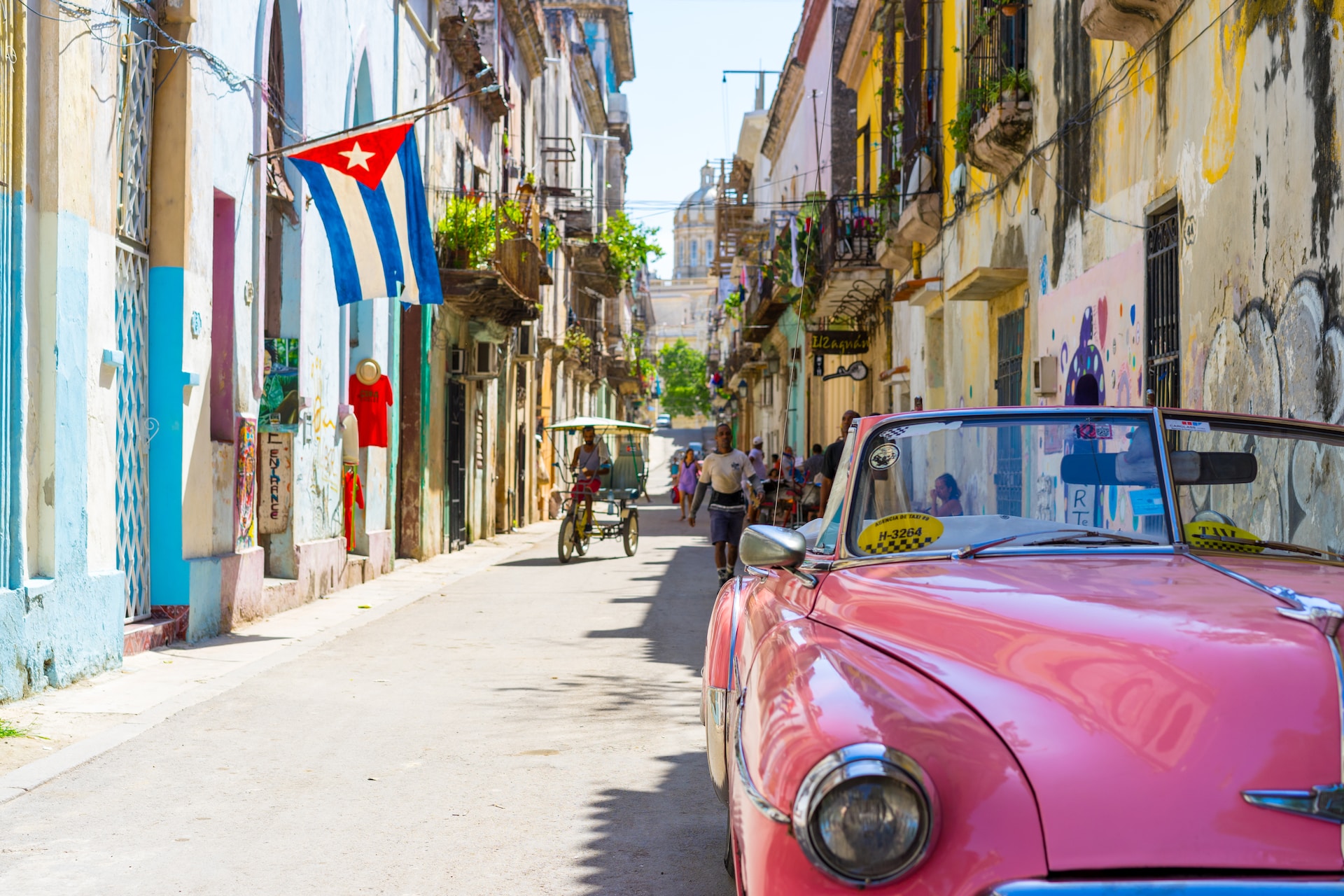
Can American citizens vacation in Cuba? If you’re an American, this question may have crossed your mind. While the answer isn’t straightforward, it’s a journey worth taking. Let’s dive in and unveil the curious question.
The Cuba Conundrum
In my humble opinion, everyone has a bucket list destination they fantasize about visiting one day. The kind of place that you’d find clipped out in a scrapbook or pinned on a “Must Visit” Pinterest board. For many, this place is none other than the charming, time-encapsulated wonder known as Cuba.
Cuba has long captivated the imaginations of travelers around the globe, but can American citizens vacation in Cuba? Let’s dive right in and explore what a vacation in Cuba entails for American travelers.
The Cuban Vacation: A Taboo for Americans?
In short, yes, American citizens can vacation in Cuba. However, the situation isn’t as straightforward as hopping on the next flight to Havana and sipping Mojitos on the Malecon. There are restrictions and requirements to navigate.
Know Before You Go: Navigating the Regulations
While planning a Cuba vacation, American citizens need to adhere to specific U.S. government regulations. These include:
- Choosing from 12 authorized categories of travel: These range from family visits to professional research, religious activities, and humanitarian projects. The category of “Support for the Cuban People” is often used by individual travelers.
- Keeping a full schedule: U.S. citizens need to engage in activities that support the Cuban people and aren’t typical tourist activities.
- Retaining records: Travelers must keep detailed records of their travels and expenses for five years.
Moving on, let’s peek at some of the unforgettable experiences Cuba has to offer.
Is Cuba a Good Place to Vacation? The Alluring Allure of Cuba
There’s more to Cuba than vintage cars and pastel-colored architecture. Its culture, people, and landscapes are the real treasures waiting to be discovered. Let’s explore some examples.
Authentic Havana A City of Intrigue and Allure
Havana, the country’s vibrant capital, is filled with incredible experiences. Whether you’re a history buff or an architecture lover, the Must See Spots in Havana are sure to impress you.
Havana, Cuba’s capital city, is an absolute treasure trove of experiences. It’s a sensory feast with a myriad of colors, sounds, and scents. From classic cars and colorful architecture to pulsating music and friendly locals, Havana is nothing short of enchanting.
Architectural Charm
Havana’s architectural tapestry is an eclectic mix of styles ranging from Spanish colonial to Art Deco. The heart of this display is undoubtedly Habana Vieja, or Old Havana, a UNESCO World Heritage site. It’s a delightful maze of narrow alleys, grand plazas, and pastel-colored buildings that echo stories of a bygone era.
Historical Spots
Havana boasts a wealth of historical landmarks. Don’t miss El Capitolio, an imposing building resembling the U.S. Capitol, or the grandiose Great Theatre of Havana, home to the Cuban National Ballet. And then there’s the 16th-century Castillo de la Real Fuerza, one of the oldest existing forts in the Americas.
Cultural Experiences
Havana is also a city of dynamic cultural experiences. Visit the Museo de la Revolución for a fascinating insight into Cuba’s revolutionary history or take a stroll along the Malecón, a 5-mile-long promenade that’s a social hub for locals.
Cuban Beats
If music makes your world go round, then Havana won’t disappoint. It’s the birthplace of genres like mambo and cha-cha, and music fills the air in bars, cabarets, and impromptu street-side performances.
Vintage Vibes
Let’s not forget the iconic vintage cars that add to Havana’s old-world charm. Hop into a classic Chevrolet or Ford for a nostalgic ride around the city.
Cigar Culture
And for the cigar aficionados, a visit to a cigar factory like Partagás or La Corona offers an insight into the age-old tradition of cigar-making.
In summary, Havana encapsulates the essence of Cuba in a beautiful, bustling, and vibrant way. To get the most out of your visit to this enchanting city, don’t miss these Must See Spots in Havana.
Tranquil Trinidad: A Time Capsule of the Past
If a quiet retreat is more your style, the quaint town of Trinidad offers cobblestone streets, live salsa music, and stunning views from the bell tower at Iglesia y Convento de San Francisco.
Trinidad, a UNESCO World Heritage Site, is often referred to as the “Museum City of Cuba.” Its beautifully preserved Spanish colonial architecture, cobblestone streets, and relaxed pace make it a must-visit for anyone looking for a tranquil escape.
Architectural Wonders
Walking through the streets of Trinidad is like taking a step back in time. The well-preserved buildings, such as the Museo Romántico and the Palacio Cantero, feature charming Spanish colonial architecture that dates back to the 17th century. And let’s not forget the iconic bell tower at the Iglesia y Convento de San Francisco, which offers breathtaking panoramic views of the city and the sea.
Enthralling Music Scene
Trinidad is not just about quietude and architecture, it’s also a hub for music lovers. Live salsa music is a staple here, and you’d often find locals and tourists dancing to the rhythm at Casa de la Musica, an outdoor venue set on the steps leading to Plaza Mayor, the city’s main square.
Natural Beauty
Just a short drive from Trinidad is the lush Topes de Collantes National Park. Here you can hike through coffee plantations, bathe in waterfalls, and discover endemic species of flora and fauna.
Local Life
Last but not least, the true beauty of Trinidad lies in its people. Warm and welcoming, they are what truly makes Trinidad an unforgettable destination. From local artisans crafting unique souvenirs to friendly farmers inviting you for a home-brewed coffee, every encounter adds to the charm of this place.
So, whether you’re after historical intrigue, rhythmic beats, or natural escapades, Trinidad offers it all, proving why it is such a captivating part of a Cuban vacation. For a deeper dive into the top attractions of this gem, don’t forget to check out this insightful guide on Trinidad.
Cuban Cuisine and Drinks
No trip to Cuba is complete without a taste of its unique cuisine and legendary cocktails, like the Mojito and Cuba Libre.
In my humble opinion, no cultural exploration is complete without a deep dive into the local cuisine. When it comes to Cuban food and beverages, we’re talking about an amalgamation of Spanish, African, and Caribbean flavors that create a unique culinary landscape. Let’s explore some of the delightful treats that Cuba has to offer.
Cuban Food
Ropa Vieja: This hearty and savory dish, which literally translates to “old clothes”, is considered Cuba’s national dish. It’s a flavorful stew made of shredded beef, tomatoes, bell peppers, onions, and a mix of spices. It’s traditionally served with rice and fried plantains.
Cuban Sandwich: Introduced by Cuban immigrants in Florida, this is a must-try when you’re in Miami. However, the original version of the Cuban sandwich, or ‘mixto’, can still be found in Cuba. The sandwich contains ham, roasted pork, Swiss cheese, pickles, and mustard packed in Cuban bread and pressed until the cheese is melted and the bread toasted.
Moros y Cristianos: This is a classic Cuban side dish of black beans (moros) and white rice (cristianos) that reflects the African and Spanish influences in Cuban cuisine. The beans are cooked with onions, green peppers, and garlic, then mixed with rice, making a hearty and satisfying dish.
Cuban Drinks
Mojito: An iconic Cuban cocktail, the Mojito consists of white rum, fresh mint, lime juice, sugar, and soda water. It’s a refreshing and tangy drink that’s synonymous with Cuban culture.
Cuba Libre: Also known as a Rum and Coke, the Cuba Libre is another classic Cuban cocktail. It is said to have been created during the Spanish-American War and has remained a popular choice ever since. The drink is a simple blend of Cuban rum, coke, and a generous squeeze of lime.
Cuban Coffee: Cuba is famous for its strong, sweet coffee. The most popular version, café cubano, is a type of espresso that has demerara sugar added to the espresso pitcher, resulting in a sweet, foamy layer on top of the coffee.
In conclusion, Cuban cuisine and drinks offer an array of flavors and experiences. Whether you’re a foodie or a casual traveler, these dishes and beverages will undoubtedly enrich your Cuban vacation.
The Historic Link Between Cuba and Tampa: A Tale of Two Cities
When it comes to the shared history of Cuba and Tampa, Florida, it’s a fascinating tale that intertwines culture, economics, and politics in an extraordinary manner. The relationship dates back to the 19th century, leading to an enduring connection that has profoundly shaped both locales.
Ybor City and the Cuban Influence
The historic neighborhood of Ybor City in Tampa, also known as “Cigar City,” serves as a testament to the deep ties between Tampa and Cuba. The district was founded in the 1880s by a group of businessmen led by Vicente Martinez-Ybor, a Spanish entrepreneur who had migrated from Cuba.
Ybor moved his cigar manufacturing operations from Key West to Tampa, and the industry exploded. Thousands of Cuban cigar workers relocated to Tampa, significantly influencing the city’s culture, economy, and identity.
Mutual Struggles for Independence
Cuba’s struggle for independence from Spain also found an ally in Tampa. The city’s cigar factories served as a meeting place for pro-independence gatherings, and Jose Marti, the celebrated Cuban national hero, frequented Tampa to raise funds and awareness for the cause.
The Birth of the Cuban Sandwich
Another significant link between Cuba and Tampa is the iconic Cuban sandwich. Though its name suggests a Cuban origin, the Cuban sandwich as we know it was actually born in Ybor City, Tampa. It was originally a lunch meal for the Cuban immigrant workers in the cigar factories and incorporated ingredients representing the diverse communities in the area: ham (the Spanish), pork (the Cubans), salami (the Italians), Swiss cheese, pickles, and mustard.
Continued Cultural Exchange
The relationship between Tampa and Cuba has continued over the years. Thousands of Cubans settled in Tampa during the 1960s following the Cuban Revolution. The cultural exchange has permeated multiple facets of Tampa life, from food and music to arts and festivals, ensuring the Cuban influence remains vibrant.
In conclusion, the historic link between Cuba and Tampa is a compelling narrative of shared histories, migratory movements, and cultural blending, leaving an indelible mark on both places.
How Americans Can Get to Havana: A Handy Guide
Planning a trip to Havana, Cuba, as an American can feel like a journey into uncharted territory, primarily due to the unique travel restrictions in place. However, with a little bit of guidance, the process becomes much less daunting. Let’s dive right in and see how you can make this dream vacation a reality.
Step 1: Choose Your Travel Category
U.S. law specifies 12 categories of authorized travel to Cuba, each with specific criteria. Some common ones chosen by travelers include ‘Support for the Cuban People’, ‘Professional Research’, and ‘Educational Activities’. Make sure you understand the obligations and activities each category entails.
Step 2: Purchase Your Visa
Once you’ve chosen a travel category, you will need to purchase a tourist visa, also known as a tourist card. Most airlines offer these for sale either during your flight booking process or at the airport on the day of your departure.
Step 3: Book Your Flight
Direct flights from the U.S. to Havana are available, primarily from major hubs such as Miami and New York. The flight duration is quite short, ranging from 45 minutes from Miami to 3 hours from New York.
Step 4: Arrange Your Accommodation
Accommodations in Havana range from luxury hotels to more affordable “casas particulares,” or private homes. Airbnb also operates in Cuba, offering a wide range of options.
Step 5: Secure Travel Insurance
Travel insurance is mandatory for all visitors to Cuba. Some airlines include Cuban health insurance in the cost of your ticket, but be sure to verify this and purchase additional insurance if necessary.
Step 6: Prepare for Money Matters
It’s essential to note that American credit and debit cards do not work in Cuba, so you’ll need to bring enough cash for your entire trip. Upon arrival, you can exchange your money for Cuban Convertible Pesos (CUCs) or Cuban Pesos (CUPs).
Step 7: Plan Your Itinerary
Americans are required to have a full-time schedule of activities related to their selected travel category. Thus, plan your itinerary carefully, ensuring it adheres to the regulations.
There you have it, folks! While the process to get to Havana might involve a few extra steps, it’s all part of the adventure. And believe me, the rich cultural experiences, warm people, and charming streets of Havana make it all worth it! Remember to check this list of Must See Spots in Havana while planning your trip. Happy travels!
The Verdict: Can American citizens vacation in Cuba?
While Cuba may not be the easiest option for a Spring Break trip, it undoubtedly offers an unforgettable experience for the intrepid traveler. So, if you ask me, “Can American citizens vacation in Cuba?” the answer would be a resounding “Yes, but…”.




